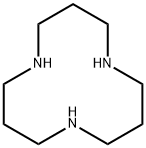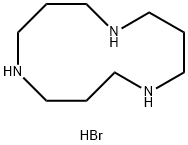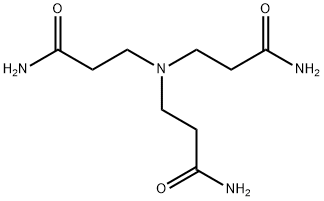DIPROPYLENETRIAMINE
Synonym(s):BAPA;Norspermidine;Dipropylenetriamine;N-(3-Aminopropyl)-1,3-propanediamine;3,3′-Diaminodipropylamine
- CAS NO.:56-18-8
- Empirical Formula: C6H17N3
- Molecular Weight: 131.22
- MDL number: MFCD00008214
- EINECS: 200-261-2
- SAFETY DATA SHEET (SDS)
- Update Date: 2024-12-18 14:07:02

What is DIPROPYLENETRIAMINE?
Chemical properties
colourless to yellow liquid
The Uses of DIPROPYLENETRIAMINE
A structural homologue of the natural polyamine spermidine with antitumor activity that may make it useful as a antineoplastic agent.
The Uses of DIPROPYLENETRIAMINE
Bis(3-aminopropyl)amine (BAPA) can be used:
- To synthesize chitosan based hydrogels having potential biomedical applications.
- For the functionalization of nanoparticles to yield terminal ?NH2 groups for further modifications.
- As an internal dispersing agent for the synthesis of water-dispersible polyurethanes.
- As a ligand in the preparation of [Cu(bapa)]2[Mo(CN)8]·7H2O photomagnetic coordination polymer.
Definition
ChEBI: Bis(3-aminopropyl)amine is a polyazaalkane. It has a role as an algal metabolite and a plant metabolite. It is a conjugate base of a bis(3-azaniumylpropyl)azanium.
What are the applications of Application
Bis(3-aminopropyl)amine is a structural homologue of the natural polyamine spermidine
Synthesis Reference(s)
The Journal of Organic Chemistry, 58, p. 3736, 1993 DOI: 10.1021/jo00066a028
Journal of the American Chemical Society, 105, p. 5002, 1983 DOI: 10.1021/ja00353a025
General Description
A colorless liquid. Less dense than water. Flash point of 170°F. Very irritating to skin and eyes, and may be toxic by ingestion. Used to make soaps, dyes, and pharmaceuticals.
Air & Water Reactions
Water soluble.
Reactivity Profile
DIPROPYLENETRIAMINE neutralize acids in exothermic reactions to form salts plus water. May be incompatible with isocyanates, halogenated organics, peroxides, phenols (acidic), epoxides, anhydrides, and acid halides. Flammable gaseous hydrogen is generated by amines in combination with strong reducing agents, such as hydrides. DIPROPYLENETRIAMINE can react with oxidizing materials .
Hazard
Toxic by ingestion and inhalation; irritant.
Health Hazard
TOXIC; inhalation, ingestion or skin contact with material may cause severe injury or death. Contact with molten substance may cause severe burns to skin and eyes. Avoid any skin contact. Effects of contact or inhalation may be delayed. Fire may produce irritating, corrosive and/or toxic gases. Runoff from fire control or dilution water may be corrosive and/or toxic and cause pollution.
Fire Hazard
Combustible material: may burn but does not ignite readily. When heated, vapors may form explosive mixtures with air: indoors, outdoors and sewers explosion hazards. Contact with metals may evolve flammable hydrogen gas. Containers may explode when heated. Runoff may pollute waterways. Substance may be transported in a molten form.
Safety Profile
Poison by skin contact. Moderately toxic by ingestion. A skin and severe eye irritant. When heated to decomposition it emits toxic fumes of NO,. An explosive
Purification Methods
Dry the amine with Na and distil it under vacuum. [Beilstein 4 IV 1278.]
Properties of DIPROPYLENETRIAMINE
| Melting point: | −14 °C(lit.) |
| Boiling point: | 151 °C50 mm Hg(lit.) |
| Density | 0.938 g/mL at 25 °C(lit.) |
| refractive index | n |
| Flash point: | 245 °F |
| storage temp. | 2-8°C |
| Water Solubility | Completely miscible in water |
| solubility | Chloroform (Slightly), Methanol (Slightly) |
| pka | pK1:8.02(+2);pK2:9.70(+1);pK3:10.70(0) (30°C) |
| form | clear liquid |
| color | Colorless to Almost colorless |
| BRN | 1071254 |
| Stability: | Air and light sensitive. Combustible. Incompatible with oxidizing agents. |
| CAS DataBase Reference | 56-18-8(CAS DataBase Reference) |
| EPA Substance Registry System | Norspermidine (56-18-8) |
Safety information for DIPROPYLENETRIAMINE
| Signal word | Danger |
| Pictogram(s) |
 Corrosion Corrosives GHS05  Skull and Crossbones Acute Toxicity GHS06  Health Hazard GHS08 |
| GHS Hazard Statements |
H302:Acute toxicity,oral H311:Acute toxicity,dermal H314:Skin corrosion/irritation H317:Sensitisation, Skin H330:Acute toxicity,inhalation H341:Germ cell mutagenicity H373:Specific target organ toxicity, repeated exposure |
| Precautionary Statement Codes |
P201:Obtain special instructions before use. P280:Wear protective gloves/protective clothing/eye protection/face protection. P301+P330+P331:IF SWALLOWED: Rinse mouth. Do NOT induce vomiting. P303+P361+P353:IF ON SKIN (or hair): Remove/Take off Immediately all contaminated clothing. Rinse SKIN with water/shower. |
Computed Descriptors for DIPROPYLENETRIAMINE
New Products
4-Fluorophenylacetic acid 4-Methylphenylacetic acid N-Boc-D-alaninol N-BOC-D/L-ALANINOL Tert-butyl bis(2-chloroethyl)carbamate 3-Morpholino-1-(4-nitrophenyl)-5,6-dihydropyridin- 2(1H)-one Furan-2,5-Dicarboxylic Acid Tropic acid S-2-CHLORO PROPIONIC ACID ETHYL ISOCYANOACETATE 2-Bromo-1,3-Bis(Dimethylamino)Trimethinium Hexafluorophosphate (6-METHYL-[1,3]DITHIOLO[4,5-b]QUINOXALIN-2-ONE INDAZOLE-3-CARBOXYLIC ACID 4-IODO BENZOIC ACID (2-Hydroxyphenyl)acetonitrile 4-Bromopyrazole 5,6-Dimethoxyindanone 2-(Cyanocyclohexyl)acetic acid 4-methoxy-3,5-dinitropyridine 2-aminopropyl benzoate hydrochloride 1-(4-(aminomethyl)benzyl)urea hydrochloride diethyl 2-(2-((tertbutoxycarbonyl)amino) ethyl)malonate tert-butyl 4- (ureidomethyl)benzylcarbamate Ethyl-2-chloro((4-methoxyphenyl)hydrazono)acetateRelated products of tetrahydrofuran



![3-[3-(2-Iodoacetamido)propylcarbamoyl]-PROXYL](https://img.chemicalbook.in/CAS/GIF/77695-02-4.gif)




You may like
-
 3,3'-Diaminodipropylamine CAS 56-18-8View Details
3,3'-Diaminodipropylamine CAS 56-18-8View Details
56-18-8 -
 Bis(3-aminopropyl)amine CAS 56-18-8View Details
Bis(3-aminopropyl)amine CAS 56-18-8View Details
56-18-8 -
 1975-50-4 98%View Details
1975-50-4 98%View Details
1975-50-4 -
 2-HYDROXY BENZYL ALCOHOL 98%View Details
2-HYDROXY BENZYL ALCOHOL 98%View Details
90-01-7 -
 2-Chloro-1,3-Bis(Dimethylamino)Trimethinium Hexafluorophosphate 221615-75-4 98%View Details
2-Chloro-1,3-Bis(Dimethylamino)Trimethinium Hexafluorophosphate 221615-75-4 98%View Details
221615-75-4 -
 61397-56-6 CIS BROMO BENZOATE 98%View Details
61397-56-6 CIS BROMO BENZOATE 98%View Details
61397-56-6 -
 14714-50-2 (2-Hydroxyphenyl)acetonitrile 98+View Details
14714-50-2 (2-Hydroxyphenyl)acetonitrile 98+View Details
14714-50-2 -
 118753-70-1 98+View Details
118753-70-1 98+View Details
118753-70-1